R.J. Stowell's Blog: rjsomeone, page 60
August 21, 2018
L.H.O.O.Q.
 There's a take on the Mona Lisa by Marcel DuChamp in which the painting is recreated with the letters L.H.O.O.Q. stenciled across the bottom. When pronounced phonetically in French (el-aash-o-o-cool), it mimics the line "She's got a hot ass." It was DuChamp's way of stating what Walter Benjamin theorized in the essay, "The Work of Art in the Age of Mechanical Reproduction," in which he argues that mechanical reproduction destroys the aura of an artwork, stripping it from the unique contexts that surround it. Back in the day, one had to actually go somewhere to view a statue or listen to music; today we can conjure images, sounds, and replicas of images and sounds in books, on stereos, TVs, and laptops, indeed on street corners where vendors sell mouse pads with Leonardo's painting. That's mechanical reproduction. Snatched from museums and performance halls and scattered throughout the world, art has lost the determinate surroundings, purpose, and framings that, in another era, were nearly inseparable from it.
There's a take on the Mona Lisa by Marcel DuChamp in which the painting is recreated with the letters L.H.O.O.Q. stenciled across the bottom. When pronounced phonetically in French (el-aash-o-o-cool), it mimics the line "She's got a hot ass." It was DuChamp's way of stating what Walter Benjamin theorized in the essay, "The Work of Art in the Age of Mechanical Reproduction," in which he argues that mechanical reproduction destroys the aura of an artwork, stripping it from the unique contexts that surround it. Back in the day, one had to actually go somewhere to view a statue or listen to music; today we can conjure images, sounds, and replicas of images and sounds in books, on stereos, TVs, and laptops, indeed on street corners where vendors sell mouse pads with Leonardo's painting. That's mechanical reproduction. Snatched from museums and performance halls and scattered throughout the world, art has lost the determinate surroundings, purpose, and framings that, in another era, were nearly inseparable from it.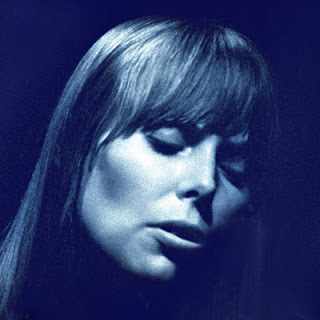 But doesn't recorded music negate Benjamin's thesis? Should we only hear music in a venue with the musician there before us? I wish. Take me back to Pink Floyd in Pompeii, to Tom Waits at McCabe's Guitar Shop in Santa Monica, or to Joni anywhere. Three wishes would include a day at the very very very nice house. The point being that Benjamin's thesis is a crock and the whole argument about aura strikes me as simplistic, if not outright mistaken. Haven't books and other written artworks been subject to mechanical reproduction for as long as they've existed, and haven't they still managed to command unique and powerful auras?
But doesn't recorded music negate Benjamin's thesis? Should we only hear music in a venue with the musician there before us? I wish. Take me back to Pink Floyd in Pompeii, to Tom Waits at McCabe's Guitar Shop in Santa Monica, or to Joni anywhere. Three wishes would include a day at the very very very nice house. The point being that Benjamin's thesis is a crock and the whole argument about aura strikes me as simplistic, if not outright mistaken. Haven't books and other written artworks been subject to mechanical reproduction for as long as they've existed, and haven't they still managed to command unique and powerful auras? Nothing poses so forceful a challenge to the argument as a work like Joni Mitchell's Blue, which elegantly and affectingly succeeds in evoking the aura of a particular moment, even nearly 50 years later. Take the track, "The Last Time I Saw Richard." There is a reference to 1968 in the opening line identifying the time of the event, a precise moment in time that situates the narration around that year, but long enough after so that the speaker could refer to it with a distance that phrasing implies. There's the mention of the Wurlitzer in a "dark café" where the song takes place, which corroborates the circa-1970 feel. And then there are the "dishwasher and coffee percolator" that Richard buys for his figure skater wife as he sinks into domestic anonymity.
 "Richard" is possibly Chuck Mitchell, briefly Joni's first husband, and also her musical partner in the early 1960s. We learn that, Richard/Chuck was subsequently married to a figure skater who bought her shit and drinks by himself in front of the TV. It's lay it on the confessional journalism that on first hearing, friend, Kris Kristofferson opined, "Oh Joni – save something of yourself!" That kind of 3D honesty, even on the 53,000th pressing of Blue, unravels Benjamin's silly premise to the core (in the same way that John Lennon’s "God" cannot be analyzed with T.S. Eliot's objective correlative – the idea that great poetry requires no knowledge of the poet). In "Richard" as with the entirety of Blue, Mitchell creates the most poignant disillusionment in song. It's nearly the opposite of what we find in "All I Want" in which Joni croons, "I hate you some, I hate you some, I love you some…" Instead, in "Richard," the line would read, "I loved some, but I hate you now;" hate at its most visceral.
"Richard" is possibly Chuck Mitchell, briefly Joni's first husband, and also her musical partner in the early 1960s. We learn that, Richard/Chuck was subsequently married to a figure skater who bought her shit and drinks by himself in front of the TV. It's lay it on the confessional journalism that on first hearing, friend, Kris Kristofferson opined, "Oh Joni – save something of yourself!" That kind of 3D honesty, even on the 53,000th pressing of Blue, unravels Benjamin's silly premise to the core (in the same way that John Lennon’s "God" cannot be analyzed with T.S. Eliot's objective correlative – the idea that great poetry requires no knowledge of the poet). In "Richard" as with the entirety of Blue, Mitchell creates the most poignant disillusionment in song. It's nearly the opposite of what we find in "All I Want" in which Joni croons, "I hate you some, I hate you some, I love you some…" Instead, in "Richard," the line would read, "I loved some, but I hate you now;" hate at its most visceral.All that said, Joni Mitchell's Blue is the fucking Mona Lisa and it doesn't matter if you missed seeing her live in '71, Blue is the most poignant LP of the 70s. Okay, want to make it the most authentic experience possible? Go on eBay or to your favorite vinyl shop and buy it, an original issue on Reprise, but only in VG condition (there should be some rattle and hum). That ought to do it.
Published on August 21, 2018 04:19
On Ladies of the Canyon
 In April 1970 Joni Mitchell released her third LP, Ladies Of The Canyon, an ode to the her neighbors and the Boho neighb of Laurel Canyon, a hillside paradise nestled in the purgatory of Los Angeles. Deep in a relationship with Graham Nash, the songs reflect her homely life. "Willy" and "Blue Boy" are profound, gentle love songs to Nash, while "Morning Morgantown" and "Ladies of the Canyon" offer sweet, romantic smalltown portraits. Some of the lyrics are a bit twee, and others are overly sweet or pretty, but why not; this is paradice; on the surface, anyway. Still there is an underrated power to this record. "For Free" is one of her strongest early songs, exploring the dichotomy between being a wealthy recorded artist and a modest street busker; it also features a dazzling clarinet solo at its climax, hinting at the jazz to come, though not as well as "The Arrangement." Here is one of Joni's first songs to explore jazz structures, if not jazz textures or arrangements. It is her most experimental and challenging song up to this point, and also perhaps the most difficult song to get into. "Rainy Night House" and "The Priest" are two highlights, gems tucked away, as if they were hidden in a rustic cul-de-sac.
In April 1970 Joni Mitchell released her third LP, Ladies Of The Canyon, an ode to the her neighbors and the Boho neighb of Laurel Canyon, a hillside paradise nestled in the purgatory of Los Angeles. Deep in a relationship with Graham Nash, the songs reflect her homely life. "Willy" and "Blue Boy" are profound, gentle love songs to Nash, while "Morning Morgantown" and "Ladies of the Canyon" offer sweet, romantic smalltown portraits. Some of the lyrics are a bit twee, and others are overly sweet or pretty, but why not; this is paradice; on the surface, anyway. Still there is an underrated power to this record. "For Free" is one of her strongest early songs, exploring the dichotomy between being a wealthy recorded artist and a modest street busker; it also features a dazzling clarinet solo at its climax, hinting at the jazz to come, though not as well as "The Arrangement." Here is one of Joni's first songs to explore jazz structures, if not jazz textures or arrangements. It is her most experimental and challenging song up to this point, and also perhaps the most difficult song to get into. "Rainy Night House" and "The Priest" are two highlights, gems tucked away, as if they were hidden in a rustic cul-de-sac. Mitchell's voice is very sweet and girlish here, which is odd considering that she showed a brassier tone on the earlier Clouds. It gives the album a pretty, romantic quality, and the hit "Big Yellow Taxi" is characteristic of the album's guitar-driven songs, which are few. Ladies of the Canyon instead features piano more prominently, a move Mitchell credited to to Laura Nyro, who was, at this time, a more sophisticated and developed artist. Overall, Ladies of the Canyon was an important step forward for Joni Mitchell, adding texture and substance to her previously modest, understated acoustic pieces.
 Laurel Canyon is a geographical oddity, a jumble of undeveloped Hollywood hills that butts up to West Hollywood. By 1968, the neighborhood had become the center of the local music scene. Nearly every Los Angeles musician lived there, jammed there, or crashed on somebody's couch there: The Byrds, The Mamas & the Papas, Crosby Stills Nash and sometimes Young, The Beach Boys, The Doors, Love, a few of the Monkees, Frank Zappa, The International Submarine Band, Jackson Browne, and scores more. "It was Brigadoon meets the Brill Building," wrote Michael Walker in his 2006 best-seller Laurel Canyon: The Inside Story Of Rock-and-Roll’s Legendary Neighborhood.
Laurel Canyon is a geographical oddity, a jumble of undeveloped Hollywood hills that butts up to West Hollywood. By 1968, the neighborhood had become the center of the local music scene. Nearly every Los Angeles musician lived there, jammed there, or crashed on somebody's couch there: The Byrds, The Mamas & the Papas, Crosby Stills Nash and sometimes Young, The Beach Boys, The Doors, Love, a few of the Monkees, Frank Zappa, The International Submarine Band, Jackson Browne, and scores more. "It was Brigadoon meets the Brill Building," wrote Michael Walker in his 2006 best-seller Laurel Canyon: The Inside Story Of Rock-and-Roll’s Legendary Neighborhood.The title track paints the area as a loose commune defined by the creative zeal and gregarious spirit of its inhabitants. It's tempting to read real-life counterparts into the three women Mitchell sings about. Is Trina really a stand-in for Szou Paulekas, who recycled vintage clothing into hippie-freak fashion and defined the look of a generation? Might Annie actually be Mama Cass Elliott, widely regarded as the Gertrude Stein of Laurel Canyon? Could Estrella be Joan Baez or Laura Nyro, or even Mitchell herself?
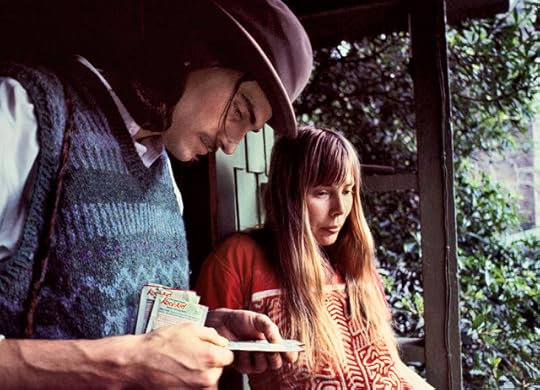
With its steep hills, winding dirt roads, and a handful of man made caves strung with lights, the canyon provided a woodsy refuge from L.A. Along with beautiful views of the city, it offered an escape from the social turmoil that defined the 1960s: the Watts riots in 1965, The Manson Family, the draft, the general sense of societal entropy – what Joan Didion in her essay "The White Album" called "the shifting phantasmagoria which is our actual experience." Ladies of the Canyon is a beautiful album, filled with yearning for the ideal world that was promised by so much of the music and culture of the '60s but by 1970 had been largely given up on (That was just a dream some of us had).
Published on August 21, 2018 04:17
August 20, 2018
Ladies of the Canyon - The Joni 70s
 1970's Ladies of the Canyon was written and recorded at the height of Joni Mitchell's early phase while living in Laurel Canyon, and is a grand debut for the Joni of the 70s. Keep in mind that our emphasis here at AM for the past month or so has been the progressive rock and the diversity of genres in rock's greatest era, it was here, on Ladies, that Joni started her venture into the hear of jazz.
1970's Ladies of the Canyon was written and recorded at the height of Joni Mitchell's early phase while living in Laurel Canyon, and is a grand debut for the Joni of the 70s. Keep in mind that our emphasis here at AM for the past month or so has been the progressive rock and the diversity of genres in rock's greatest era, it was here, on Ladies, that Joni started her venture into the hear of jazz. Deep in a relationship with Graham Nash, the songs reflect her homely life. "Willy" and "Blue Boy" are profound, gentle love songs to Nash, while "Morning Morgantown" and "Ladies of the Canyon" offer sweet, romantic small town portraits. Some of the lyrics have twee elements, and others are overly sweet or pretty, but there is an often underrated power to Joni’s hippie album. "For Free" is one of her strongest early songs, exploring the dichotomy between being a successful and wealthy recording artist and a modest street busker; it also features a dazzling clarinet solo at its climax.
"The Arrangement" is one of her first songs to explore jazz structures, if not jazz textures or arrangements. It is her most experimental and challenging song to this point, and also perhaps the least accessible. "Rainy Night House" and "The Priest" are two definite highlights, gems tucked away on this album. It takes a while for them to leap out, but they have immense staying power with their gorgeous melodies and heartfelt performances. Mitchell's voice is sweet and girlish here, somewhat odd compared with the deep tone on Clouds. It gives the album a pretty, romantic quality, and the hit "Big Yellow Taxi" is characteristic of the album's guitar-driven songs. "The Circle Game," a Joni Mitchell 'standard,' fits into this category.

Ladies of the Canyon also features piano prominently, a move Mitchell credited to listening to Laura Nyro, who was at this time perhaps a more sophisticated and developed artist. The album is notable for exploring woodwind for the first time, and it's the fullest-sounding of her early acoustic works. It also features her soaring electric piano rendition of "Woodstock."
Overall, Ladies of the Canyon was an important step forward for Joni Mitchell, adding texture and substance to her previously modest, understated acoustic pieces. She would explore these sounds further into the 1970s, but this is the most important albums in her artistic evolution.
Published on August 20, 2018 06:23
August 18, 2018
Gaucho (AM9)Artist: Steely DanProduced by: Steely Dan, Ga...
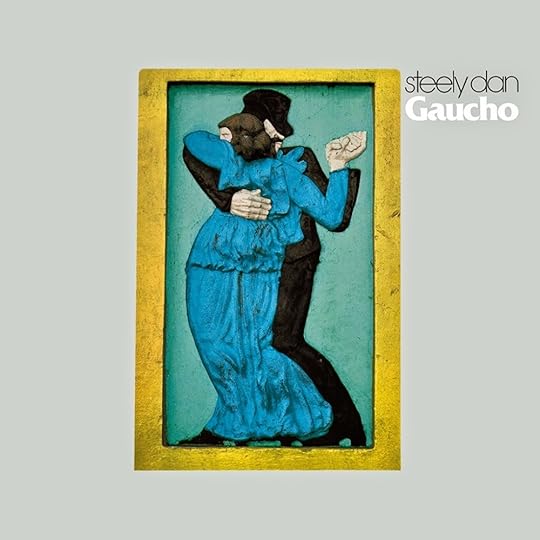 Gaucho
(AM9)
Gaucho
(AM9)Artist: Steely Dan
Produced by: Steely Dan, Gary Katz, Roger Nichols, Paul Bishow
Released: November 21, 1980
Tracks: 1) Babylon Sisters (5:55); 2) Hey Nineteen (5:10); 3) Glamour Profession (7:29) 4) Time Out of Mind (4:14); 5) My Rival (4:34); 6) Third World Man (5:13)
Players: Donald Fagen - lead vocals, synthesizer (2, 3, 4, 5, 6), electric piano (2, 3, 4, 5, 6), organ (6); Walter Becker - bass (4, 5), guitar (2), guitar solo (4); Rob Mounsey - piano (3, 4, 5), synthesizer (7); Don Grolnick - electric piano (1) and clavinet (1); Patrick Rebillot (6), Joe Sample (7) - electric piano; Steve Khan - guitar (1, 3, 4, 7), lead guitar (6); Mark Knopfler (5), Larry Carlton (7) - lead guitar; Hugh McCracken (2, 5), Hiram Bullock (6), Rick Derringer (6) - guitar; Chuck Rainey (1, 7), Anthony Jackson (3, 6) - bass; Bernard Pretty Purdie (1), Rick Marotta (2, 5), Steve Gadd (3, 6, 7), Jeff Porcaro (4) - drums; Crusher Bennett (1, 4), Steve Gadd (2), Victor Feldman (2), Ralph McDonald (3, 6), Nicholas Marrero (6) - percussion; Tom Scott - alto saxophone and clarinet (1); tenor saxophone (1, 3, 4, 6), lyricon (3, 6), horn arrangement (3, 4, 6); Michael Brecker (3, 5, 6), Dave Tofani (5) - tenor saxophone; David Sanborn - alto saxophone (5); Ronny Cuber - baritone saxophone (5); Randy Brecker - trumpet (1, 4, 5), flugelhorn (1, 6); George Marge, Walter Kane - clarinet (1); Wayne Andre - trombone (6); Rob Mounsey - horn arrangement (1, 5); Michael McDonald, Patti Austin, Valerie Simpson, Frank Floyd, Diva Gray, Gordon Grody, Lani Groves, Leslie Miller, Zachary Sanders, Toni Wine - backing vocals
The three years in which Gaucho was recorded were turbulent indeed, involving record company disputes, Donald Fagan's distaste and distrust for the West and Walter Becker's worsening issues with addiction (hit by a car, on and on); not to mention a $1 million production budget (unheard of at the time), yet it all was fodder for edgy poetics on subterranean L.A. culture. While the lyrical tone of Steely Dan has always been a quirky assault on hipsters and the cultural elite, new songs like "Babylon Sisters" and "My Rival" were substantially creepier than earlier treatises. The most telling song on the album is the eerily glossy, mildly disco-inflected funk-pop "Glamor Profession," yet, with its lyrics so heavily cloaked in metaphor, it’s doubtful many clubbers were shake shake shakin' it while deciphering the underlying meaning. The lovely arrangement of the closer "Third World Man" belies a sad tale of phoniness as someone's undoing; there's a moral in there somewhere; there's a moral in all of it - somewhere.
Gaucho is a spectacular work; the musicianship phenomenal, the melodies and arrangements spellbinding. The recording itself is rich and bright, a technical triumph. With the exception of "Black Cow," "Aja" and "Deacon Blues," these are even better tunes than its predecessor. The formula is there, certainly the musicians (42 of them) and innovations are there as well. Gaucho's flaw is trying to out-Aja Aja, and on this level, and only on this level, it fails.
Despite the poor quality of the recording, here is the infamous "Second Arrangement," notorious as a song completed and mistakenly erased during the Gaucho session. It does indeed sound very Gaucho.
Published on August 18, 2018 04:30
August 17, 2018
Aja (AM10)
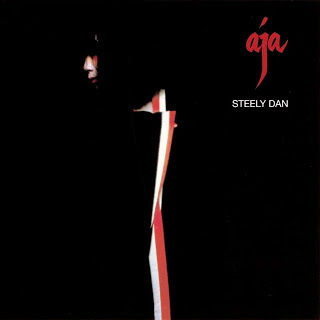 Aja (AM10)
Aja (AM10)Artist: Steely Dan
Released: September 23, 1977
Recorded: January to July 1977
Producer: Gary Katz
Tracks: 1. Black Cow - 5:10; Aja - 7:57; Deacon Blues - 7:33; 4. Peg - 3:57; 5. Home at Last - 5:34; 6. I Got the News - 5:06; 7. Josie - 4:33
Players: Donald Fagen - lead vocals (all tracks), synthesizer (all tracks but 4), police whistle (2), backing vocals (2, 5, 7); Walter Becker - bass (3), guitar (2), guitar solos (5, 6, 7); Victor Feldman - electric piano (1, 3, 7), vibraphone (5, 6), piano (5, 6), percussion (2, 4); Joe Sample - electric piano (2), clavinet (1); Paul Griffin - electric piano (4), backing vocals (4); Michael Omartian - piano (2); Don Grolnick - clavinet (4); Larry Carlton - guitar (1, 2, 3, 5, 7), guitar solo (6); Denny Dias (2), Dean Parks (3, 6, 7), Steve Khan (4) - guitar; Jay Graydon - solo guitar (4); Chuck Rainey - bass (all but 3); Paul Humphrey (1), Steve Gadd (2), Bernard Purdie (3, 5), Rick Marotta (4), Ed Greene (6) - drums; Jim Keltner - drums (7), percussion (7); Gary Coleman - percussion (4); Tom Scott - tenor saxophone (1), lyricon (4), horn arrangements; Wayne Shorter (2), Pete Christlieb (3) - tenor saxophone; Michael McDonald (4, 6), Timothy B. Schmit (2, 5, 7), Clydie King (1, 3, 6), Sherlie Matthews (1, 3, 6), Venetta Fields (1, 3, 6), Rebecca Louis (1, 6) - backing vocals; Jim Horn, Bill Perkins, Plas Johnson, Jackie Kelso - saxes/flutes; Chuck Findley, Lou McCreary, Slyde Hyde - brass
Known for their unique mixture of jazz and rock, Fagen and Becker were real New Yorkers who attained a certain west coast flair. Most of the session players (an incredible 36 of them!) were from California and this infused an unmistakable California vibe on each track. Aja represented a sonic fusion of east meets west, a truly bi-coastal affair.
Including seven songs, a touch under 40 minutes in length, the album opener "Black Cow" is a lyrically descriptive plunge into a turbulent relationship with a New York setting (Rudy's, Greene Street): "I can't cry anymore while you run around./ Break away./ Just when it seems so clear that it's over now,/ drink your big black cow and get out of here." (For curiosity's sake, a black cow is a root beer float.) Take your pick with regard to meaning, though: an ode to self-doubt, a commentary on nightlife, a reference to Hindu culture (cows are sacred)?
The stunning title track is mainstay, tour de force Dan. The arrangements are of a separate world of sophistication with a myriad of textures perfectly blended: the lyrics, the backing harmonies, the incredible Denny Dias guitar solo, the incomparable Wayne Shorter sax, the drums – there were few bands that could pull this off. Unlike the story motif from "Black Cow," the lyrics from "Aja" instead paint a picture, establish a mood, an erotic exoticism with references to Asia (angular banjos, banyan trees). Nonetheless, this is pure California fusion.
The jazzy back-to-New York style of "Deacon Blues" features Larry Carlton on guitar and as co-arranger. The thought-provoking chorus with the classic sing-a-long lyrics, beautifully accompanied by gospel backing vocals, support the song's theme of winner v. loser: "I'll learn to work the saxophone./ I’ll play just what I feel./ Drink scotch whiskey all night long/ and die behind the wheel./ They got a name for the winners in the world./ I want a name when I lose./ They call Alabama the Crimson Tide./ Call me Deacon Blues." It's shear perfection.
Aja is one of this reporter's go to LPs (alongside Blue, The Cure's Disintegration, or New Order's Lowlife) but I've often criticized it's top-heavy layout - Side Two's tracks do not compare with that opening trio. But that's not fair. Side One is unparalleled - if there was such a thing, an AM11 - yet each of Side Two's tracks are earmarked tens. Aja is another example of how one track (or tracks) belittles everything else around it (think "Bohemian Rhapsody" or "Layla"). In the hands of lesser gods, Aja may have proven disjointed and gimmicky, but Becker and Fagen's studio wizardry has made a sublimely cohesive album in which the whole is somehow still better than the sum of its uniformly perfect parts.
Published on August 17, 2018 04:25
Aja (AM10) - The Best for Last
 Aja (AM10)
Aja (AM10)Artist: Steely Dan
Released: September 23, 1977
Recorded: January to July 1977
Producer: Gary Katz
Tracks: 1. Black Cow - 5:10; Aja - 7:57; Deacon Blues - 7:33; 4. Peg - 3:57; 5. Home at Last - 5:34; 6. I Got the News - 5:06; 7. Josie - 4:33
Players: Donald Fagen - lead vocals (all tracks), synthesizer (all tracks but 4), police whistle (2), backing vocals (2, 5, 7); Walter Becker - bass (3), guitar (2), guitar solos (5, 6, 7); Victor Feldman - electric piano (1, 3, 7), vibraphone (5, 6), piano (5, 6), percussion (2, 4); Joe Sample - electric piano (2), clavinet (1); Paul Griffin - electric piano (4), backing vocals (4); Michael Omartian - piano (2); Don Grolnick - clavinet (4); Larry Carlton - guitar (1, 2, 3, 5, 7), guitar solo (6); Denny Dias (2), Dean Parks (3, 6, 7), Steve Khan (4) - guitar; Jay Graydon - solo guitar (4); Chuck Rainey - bass (all but 3); Paul Humphrey (1), Steve Gadd (2), Bernard Purdie (3, 5), Rick Marotta (4), Ed Greene (6) - drums; Jim Keltner - drums (7), percussion (7); Gary Coleman - percussion (4); Tom Scott - tenor saxophone (1), lyricon (4), horn arrangements; Wayne Shorter (2), Pete Christlieb (3) - tenor saxophone; Michael McDonald (4, 6), Timothy B. Schmit (2, 5, 7), Clydie King (1, 3, 6), Sherlie Matthews (1, 3, 6), Venetta Fields (1, 3, 6), Rebecca Louis (1, 6) - backing vocals; Jim Horn, Bill Perkins, Plas Johnson, Jackie Kelso - saxes/flutes; Chuck Findley, Lou McCreary, Slyde Hyde - brass
Known for their unique mixture of jazz and rock, Fagen and Becker were real New Yorkers who attained a certain west coast flair. Most of the session players (an incredible 36 of them!) were from California and this infused an unmistakable California vibe on each track. Aja represented a sonic fusion of east meets west, a truly bi-coastal affair.
Including seven songs, a touch under 40 minutes in length, the album opener "Black Cow" is a lyrically descriptive plunge into a turbulent relationship with a New York setting (Rudy's, Greene Street): "I can't cry anymore while you run around./ Break away./ Just when it seems so clear that it's over now,/ drink your big black cow and get out of here." (For curiosity's sake, a black cow is a root beer float.) Take your pick with regard to meaning, though: an ode to self-doubt, a commentary on nightlife, a reference to Hindu culture (cows are sacred)?
The stunning title track is mainstay, tour de force Dan. The arrangements are of a separate world of sophistication with a myriad of textures perfectly blended: the lyrics, the backing harmonies, the incredible Denny Dias guitar solo, the incomparable Wayne Shorter sax, the drums – there were few bands that could pull this off. Unlike the story motif from "Black Cow," the lyrics from "Aja" instead paint a picture, establish a mood, an erotic exoticism with references to Asia (angular banjos, banyan trees). Nonetheless, this is pure California fusion.
The jazzy back-to-New York style of "Deacon Blues" features Larry Carlton on guitar and as co-arranger. The thought-provoking chorus with the classic sing-a-long lyrics, beautifully accompanied by gospel backing vocals, support the song's theme of winner v. loser: "I'll learn to work the saxophone./ I’ll play just what I feel./ Drink scotch whiskey all night long/ and die behind the wheel./ They got a name for the winners in the world./ I want a name when I lose./ They call Alabama the Crimson Tide./ Call me Deacon Blues." It's shear perfection.
Aja is one of this reporter's go to LPs (alongside Blue, The Cure's Disintegration, or New Order's Lowlife) but I've often criticized it's top-heavy layout - Side Two's tracks do not compare with that opening trio. But that's not fair. Side One is unparalleled - if there was such a thing, an AM11 - yet each of Side Two's tracks are earmarked tens. Aja is another example of how one track (or tracks) belittles everything else around it (think "Bohemian Rhapsody" or "Layla"). In the hands of lesser gods, Aja may have proven disjointed and gimmicky, but Becker and Fagen's studio wizardry has made a sublimely cohesive album in which the whole is somehow still better than the sum of its uniformly perfect parts.
Published on August 17, 2018 04:25
August 16, 2018
The Royal Scam
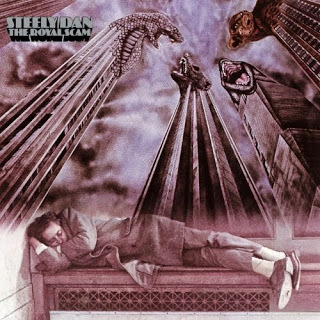 The key track on The Royal Scam (AM9), a song that makes the rest of the LP seem like gibberish, is "Kid Charlemagne." Set in 70s San Fran, "Kid C" is about a drug dealer who, in Donald Fagen's words, "had been overtaken by society and was left standing in the road with nothing." Becker, Fagen, and Katz variously described the main protagonist in the biopic as a maker, an artist, a chemist, and a chef: "Someone who makes consciousness-expanding substances of the most dramatic, sensational kind no longer in vogue." Becker said that they didn't use any particular model for the song; Fagen said he thought it was more about the age - the late sixties - and the reflections of someone who found himself in a decade where he's no longer of any use. They denied that "Kid Charlemagne" was based on a Timothy Leary or Charles Manson type character, saying that he would probably be much less of a celebrity than those examples. Becker claimed that there was an individual on whom the song was based, "who hung over the song like the Sword of Damocles," but he refuses to name names.
The key track on The Royal Scam (AM9), a song that makes the rest of the LP seem like gibberish, is "Kid Charlemagne." Set in 70s San Fran, "Kid C" is about a drug dealer who, in Donald Fagen's words, "had been overtaken by society and was left standing in the road with nothing." Becker, Fagen, and Katz variously described the main protagonist in the biopic as a maker, an artist, a chemist, and a chef: "Someone who makes consciousness-expanding substances of the most dramatic, sensational kind no longer in vogue." Becker said that they didn't use any particular model for the song; Fagen said he thought it was more about the age - the late sixties - and the reflections of someone who found himself in a decade where he's no longer of any use. They denied that "Kid Charlemagne" was based on a Timothy Leary or Charles Manson type character, saying that he would probably be much less of a celebrity than those examples. Becker claimed that there was an individual on whom the song was based, "who hung over the song like the Sword of Damocles," but he refuses to name names. 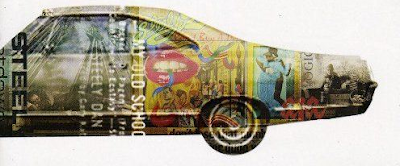 The character in "Kid Charlemagne" is opaquely based on Stanley Owsley, not the father, but the godfather of LSD. Owsley's acid biz, in part, funded the Grateful Dead in their early years. Owsley was their original sound man, and helped out with their rent as well. ("Your low rent friends are dead.") Owsley was busted when his car ran out of gas, ("Is there gas in the car?") Owsley's product was legendary among acid heads because it was "kitchen clean." The reference to "white men on the streets" refers to the growth of cocaine use and the decline in the number of people taking acid as the drug of choice. It's Steely Dan’s introspection of the scene and the incredible use of language that truly sets this song above nearly every other Dan tune and indeed elevates it to the highest poetic standard; this is Joni or Jackson or Bruce or Zimmerman, and "Kid Charlemagne" stands tall among the best of these.
The character in "Kid Charlemagne" is opaquely based on Stanley Owsley, not the father, but the godfather of LSD. Owsley's acid biz, in part, funded the Grateful Dead in their early years. Owsley was their original sound man, and helped out with their rent as well. ("Your low rent friends are dead.") Owsley was busted when his car ran out of gas, ("Is there gas in the car?") Owsley's product was legendary among acid heads because it was "kitchen clean." The reference to "white men on the streets" refers to the growth of cocaine use and the decline in the number of people taking acid as the drug of choice. It's Steely Dan’s introspection of the scene and the incredible use of language that truly sets this song above nearly every other Dan tune and indeed elevates it to the highest poetic standard; this is Joni or Jackson or Bruce or Zimmerman, and "Kid Charlemagne" stands tall among the best of these.The Royal Scam is an album that rivals even Gaucho and Aja, but takes its place more comfortably amidst Katy Lied and earlier Dan.
Published on August 16, 2018 04:18
August 15, 2018
Can't Buy a Thrill
 Steely Dan started their tenure with musicians such as guitarists Denny Dias and Jeff “Skunk” Baxter in a far more rock-oriented debut, Can’t Buy a Thrill. Walter Becker and Donald Fagen first crossed paths in 1967, when both were students at Bard College in upstate New York. Discovering they had common musical and literary interests, in addition to a shared dark sense of humor, they became fast friends. Forming a songwriting partnership, they would hone their craft over the next 5 years, first by landing a small publishing deal in New York, which then led to work as session and touring musicians with the pop group Jay And The Americans. By 1971, upon the recommendation of ABC/Dunhill producer Gary Katz, they signed on as staff songwriters and relocated to Los Angeles. During these early years, Becker and Fagen wrote a considerable amount of original material that nobody seemed keen on recording, so they took the next logical step and formed a band to record it themselves.
Steely Dan started their tenure with musicians such as guitarists Denny Dias and Jeff “Skunk” Baxter in a far more rock-oriented debut, Can’t Buy a Thrill. Walter Becker and Donald Fagen first crossed paths in 1967, when both were students at Bard College in upstate New York. Discovering they had common musical and literary interests, in addition to a shared dark sense of humor, they became fast friends. Forming a songwriting partnership, they would hone their craft over the next 5 years, first by landing a small publishing deal in New York, which then led to work as session and touring musicians with the pop group Jay And The Americans. By 1971, upon the recommendation of ABC/Dunhill producer Gary Katz, they signed on as staff songwriters and relocated to Los Angeles. During these early years, Becker and Fagen wrote a considerable amount of original material that nobody seemed keen on recording, so they took the next logical step and formed a band to record it themselves.In addition to Denny Dias and Jeff Baxter on guitars, they added drummer Jim Hodder and lead singer David Palmer. Combining a penchant for jazz, blues and R&B with the more commercial leanings of rock 'n' roll and Brill Building-era pop, Becker and Fagen sculpted their songs from a wide-ranging musical palette. Their ability to combine beautiful melodies with lyrics of an often sarcastic and cynical bent would prove a winning formula over the course of their career.
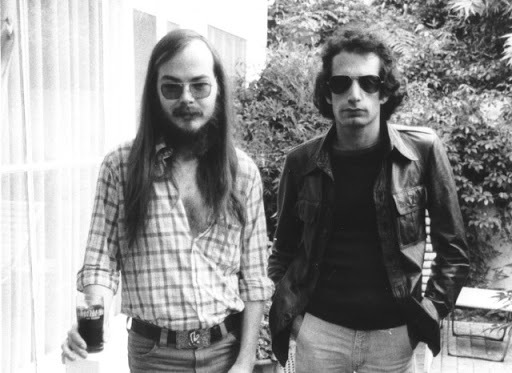
Taking their name from the steam-powered dildo in William Burroughs' novel Naked Lunch, Steely Dan set about recording their debut album, "Can't Buy A Thrill," which would spawn two unlikely hits with "Do It Again" and "Reelin'' In The Years. "Do It Again" was a breakthrough top 10 hit for the Dan, and with its lush percussion, haunting electric piano groove, ultra-catchy chorus, and the blistering electric sitar solo from Denny Dias (notice how the guy never bent a string), it's among the best singles ever. "Only A Fool Would Say That" is top-notch, and the hook-filled "Kings" is basically intriguing but for a showoff-y Elliot Randall guitar solo, which doesn't fit. The album's other big hit, "Reelin' In the Years" while a bit threadbare by now is still a quality song that's undeniably crafted and catchy with great chorus harmonies. "Turn That Heartbeat Over Again" is frustratingly fragmented, and despite all its ideas, it feels rather aimless and not fully realized. Although Fagen handles most of the lead vocals on here, David Palmer was with the group at this early stage as an additional lead vocalist, partly because of Fagen's stage fright. "Dirty Work" and the steel guitar-laden "Brooklyn (Owes the Charmer Under Me)” are fine tunes that don't necessarily sound Dan-ish. "Midnight Cruiser", with drummer Jim Hodder on lead vocals, starts off really nice, and it's respectably tuneful, but the chorus feels lazily underwritten & tossed off. "Fire In the Hole" feels half-baked like so much of the rest, as if the LP wasn’t fully actualized, although this critique is jaded by every other LP that came after it. "Change of the Guard" is sort of a feel-good tune and a sugar-coated attempt at being upbeat. In the end, Can't Buy A Thrill (excuse the pun) is a highly respectable album, but not on the same level as masterpieces such as Katy Lied and Aja (what, indeed, is on a level with Aja?).
Published on August 15, 2018 06:56
August 13, 2018
Steely Dan 101
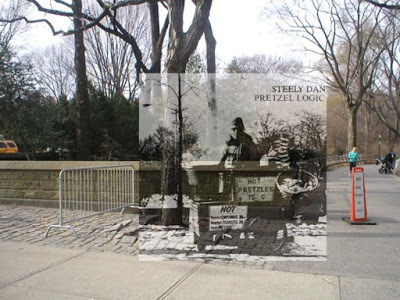 Central ParkIn January 1974, Joni Mitchell released the exquisite, deceptively sunny Court and Spark; two months later, the Ramones played their first gig. It was a year of glam and a year of celestial jamming (Bowie, Grateful Dead, Sparks and Yes, to provide a short list of diversity). Donald Fagen and Walter Becker sat uneasily in this world of earnest sentiment and antediluvian riffing. An impassively odd couple with encyclopedic jazz smarts and a glowering, gnomic mien, Steely Dan in many ways sat midway between Joni and the Ramones: pinup idols of the urbane Los Angeles studio scene but with bags of spiky, shades-after-midnight New York attitude.
Central ParkIn January 1974, Joni Mitchell released the exquisite, deceptively sunny Court and Spark; two months later, the Ramones played their first gig. It was a year of glam and a year of celestial jamming (Bowie, Grateful Dead, Sparks and Yes, to provide a short list of diversity). Donald Fagen and Walter Becker sat uneasily in this world of earnest sentiment and antediluvian riffing. An impassively odd couple with encyclopedic jazz smarts and a glowering, gnomic mien, Steely Dan in many ways sat midway between Joni and the Ramones: pinup idols of the urbane Los Angeles studio scene but with bags of spiky, shades-after-midnight New York attitude. AjaDorm buddies who met at Bard College in New York, Becker and Fagen started out in a band called the Bad Rock Group, with Chevy Chase, no less, on drums. They were over-literate beatniks with midnight-cafeteria tans and their own hinky, Beat-derived argot. Their second band found its name courtesy of William Burroughs: Steely Dan 111 is a garrulous sex aid, a minor player in the fizzing mind/body loop of Naked Lunch. Musically, the Dan were more jazz-inflected than rock-driven, filled out by a movable feast of session musician pals. For their debut single, they picked "Do It Again," a baleful lament about finding nothing new under the sun. At a time when sitars played as prettily exotic signifiers of limpid bliss, they amped one up for a biting, nerve-jangled solo. At a time when Rolling Stone ran long, fawning Q & As with addled vocalists and the counterculture was sold on faux revolutionary emblems, Becker and Fagen essayed a light samba to declare that it was all bunk: "A world become one, of salads and sun? Only a fool would say that."
AjaDorm buddies who met at Bard College in New York, Becker and Fagen started out in a band called the Bad Rock Group, with Chevy Chase, no less, on drums. They were over-literate beatniks with midnight-cafeteria tans and their own hinky, Beat-derived argot. Their second band found its name courtesy of William Burroughs: Steely Dan 111 is a garrulous sex aid, a minor player in the fizzing mind/body loop of Naked Lunch. Musically, the Dan were more jazz-inflected than rock-driven, filled out by a movable feast of session musician pals. For their debut single, they picked "Do It Again," a baleful lament about finding nothing new under the sun. At a time when sitars played as prettily exotic signifiers of limpid bliss, they amped one up for a biting, nerve-jangled solo. At a time when Rolling Stone ran long, fawning Q & As with addled vocalists and the counterculture was sold on faux revolutionary emblems, Becker and Fagen essayed a light samba to declare that it was all bunk: "A world become one, of salads and sun? Only a fool would say that."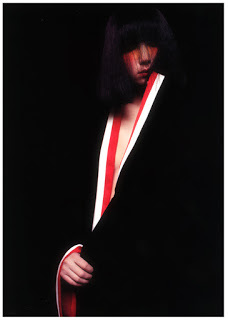 Japanese Model Sayoko YamaguchiThe divisiveness between music (Cali Vs. London) was as in your face in 1973 as the distrust of a disgraced president. Becker and Fagen definitively fit the L.A. laid back jazz riff that prevailed, but the Dan established a point of negotiation between what was happening in L.A. at the time and a new New York scene, one that vaguely resembled what was left of the Velvet's New York. It wasn't the music though that sparked the new New York sensibilities, but the attitude.
Japanese Model Sayoko YamaguchiThe divisiveness between music (Cali Vs. London) was as in your face in 1973 as the distrust of a disgraced president. Becker and Fagen definitively fit the L.A. laid back jazz riff that prevailed, but the Dan established a point of negotiation between what was happening in L.A. at the time and a new New York scene, one that vaguely resembled what was left of the Velvet's New York. It wasn't the music though that sparked the new New York sensibilities, but the attitude. Way back when, in 77, I was playing Aja on my high school radio station as a personal statement. In an era when disco ruled the airwaves, Aja was (and remains) the height and breadth of brilliant songcraft and drop dead gorgeous musicianship - way, way ahead of its time. No matter your muscial tastes, you'll recognize the brilliance and transcendence of this masterpiece. A friend lived in a house at the top of the San Fernando Valley, a glass and steel mid-century modern deal with a pool. ("You could see the Valley barbecues from the windowsill.") It was a house that screamed Steely Dan (and Joni). A house that was L.A. in the 70s. Aja was that soundtrack, and we'd sit in the living room and groove on Wayne Shorter's sax and Ritenour and Khan. One of the most beautiful albums ever recorded. Not much to say beyond that.
 At random: Part and parcel of listening to Steely Dan is sorting through the litany of proper references running the gamut from the mundane to the arcane. Far from being exhaustive, following is a modest collection of Steely Dan oddities:
At random: Part and parcel of listening to Steely Dan is sorting through the litany of proper references running the gamut from the mundane to the arcane. Far from being exhaustive, following is a modest collection of Steely Dan oddities:Locations: Camarillo ("Parker’s Band;" refers to Camarillo State Hospital); Barrytown ("Barrytown"); Guadalajara ("My Old School"); Hackensack and Lhasa ("Time out of Mind"); Muswellbrook ("Black Friday;" Wales?); Scarsdale ("Hey 19"); Barbados ("Glamour Profession"); Altamira ("The Caves of Altamira;" refers to the cave paintings in Northern Spain); City of St. John ("The Royal Scam").Drinks: Black Cow ("Black Cow"); Cuervo Gold ("Hey 19"); Kirschwasser ("Babylon Sisters"); retsina ("Home at Last;" Greek wine); Scotch Whisky ("Deacon Blues"); Zombie ("Haitian Divorce"); grapefruit and cherry wine ("FM" and "Time Out of Mind,").People: Cathy Berberian ("Your Gold Teeth"); Jungle Jim ("Glamour Profession"); Mr. Parker ("Parker’s Band"); The Eagles ("Tell Me Everything"); Dr. Wu ("Dr Wu").Arcane Slang: Cheaters ("Everyone’s Gone to the Movies;" glasses); chasing the dragon ("Time out of Mind;" smoking heroin).Cars: Lark ("I Got the news"); El Dorado ("Daddy Don’t Live in that City No More"); Chrysler ("Glamour Profession").
Miscellaneous: Luger ("With a Gun"); Fez; ("The Fez"); and Banyan Trees ("Aja").
Published on August 13, 2018 06:16
August 12, 2018
Have No Fear, Audiophiles
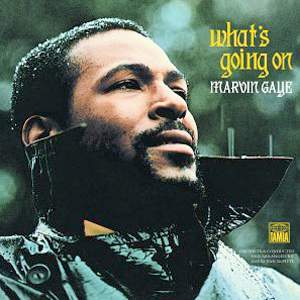 Audiophiles will put on Dark Side and listen for flaws. Not to belittle them, but to relish in them, to find what's hidden and captured unexpectedly (like The Beatles' "Day Tripper" in "Eclipse" or the odd warping sound in the very last seconds of "The Great Gig in the Sky"). That kind of attention to detail is why most audiophiles (like me) find little to their satisfaction with today's popular music. No doubt Radiohead and Muse, Fleet Foxes and Lord Huron will satisfy the audiophile's desires, but most modern music is mastered to sound loud even when played at low volumes – a compressed dynamic range means that there's not much difference in decibels between the quiet and loud parts of the music. Listening to these albums through high quality audio gear can be a horrific assault on the senses, which is why audiophiles seek out albums that have been mastered with a wider dynamic range (forget that most rap is clichéd couplets set amidst a lack of instrumentation – but I digress). The 90s are the era I enjoy the least, based on its mediocrity and the sparsity of great music (Radiohead and a small handful of others noted as the exception), but I'm good with the teens (is that what our era is called?), loving the new focus on Americana (The Roosevelts, Sun Kil Moon, Midlake, even Neil (forever) Young) and alt. bands like Andrew McMahon in the Wilderness or Empire of the Sun. But the world of digital downloads and MP3s has done a number across the board in terms of the audiophile – fear not, AM is here to help. Got that new vacuum tube based receiver and a turntable from Shinola? Here’s a handful of essentials.
Audiophiles will put on Dark Side and listen for flaws. Not to belittle them, but to relish in them, to find what's hidden and captured unexpectedly (like The Beatles' "Day Tripper" in "Eclipse" or the odd warping sound in the very last seconds of "The Great Gig in the Sky"). That kind of attention to detail is why most audiophiles (like me) find little to their satisfaction with today's popular music. No doubt Radiohead and Muse, Fleet Foxes and Lord Huron will satisfy the audiophile's desires, but most modern music is mastered to sound loud even when played at low volumes – a compressed dynamic range means that there's not much difference in decibels between the quiet and loud parts of the music. Listening to these albums through high quality audio gear can be a horrific assault on the senses, which is why audiophiles seek out albums that have been mastered with a wider dynamic range (forget that most rap is clichéd couplets set amidst a lack of instrumentation – but I digress). The 90s are the era I enjoy the least, based on its mediocrity and the sparsity of great music (Radiohead and a small handful of others noted as the exception), but I'm good with the teens (is that what our era is called?), loving the new focus on Americana (The Roosevelts, Sun Kil Moon, Midlake, even Neil (forever) Young) and alt. bands like Andrew McMahon in the Wilderness or Empire of the Sun. But the world of digital downloads and MP3s has done a number across the board in terms of the audiophile – fear not, AM is here to help. Got that new vacuum tube based receiver and a turntable from Shinola? Here’s a handful of essentials.Marvin Gaye's What's Going On?
Marvin Gaye's brother's experiences in the Vietnam War and the widespread social injustice in America in the early 70s led Gaye to slough off his lover’s image and record a concept album, the first for a black artist in pop music, about the shape of civilization. All of its songs flow into one another, ending with a reprise of its opening theme, all the better to tell the story of a Vietnam veteran who has come home from war to see his country in a new and disappointing light. Gaye tackles poverty, drug addiction and even environmental issues, not through angry political tirades, but as a man who believes that love is the answer. As a recording, the album exhibits a rare sonic spaciousness, with each layer, counterbalancing its blues, jazz and soul underpinnings. Listen on remastered vinyl if at all possible. This isn’t a sonic space-scape from which we expect hi-fidelity (like Close to the Edge), but one of the best examples of how all music should sound. This is the music, like Stevie Wonder's Innervisions, that serves as the best aural example of living in the inner city.
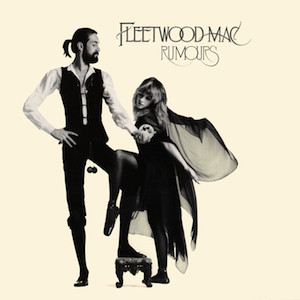 Fleetwood Mac's Rumours
Fleetwood Mac's RumoursRumours' meta-story is set amongst two intra-band breakups and rampant cocaine consumption, a veritable soap opera; so much so that at a concert I attended in Santa Barbara, the band got through just three songs before Stevie stumbled off the stage in cocaine-induced stupor, the concert postponed.
Rumours is essentially an unhappy love story with a happy ending. In the end, what you had was a masterpiece of pop. To date, the LP has moved more than 50 million copies worldwide, making it one of the biggest-selling albums of all time. Aside from the pop-hit formula prevalent with each track, the recording is a sonic triumph. Interestingly, its popularity led to the production of Tusk, not as good an LP by half, but one of the greatest produced and mastered LPs of all time. Listen to either and find hi-fidelity in its purest form.
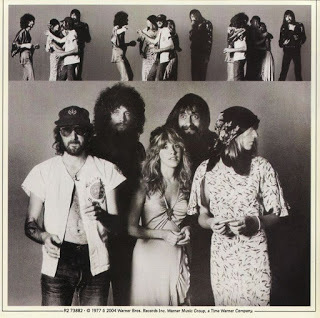 While the songwriting and performances were obviously central to the album's success, the production and engineering cannot be discounted. "We had a lot of time to dial everything in, and the band members were incredibly tolerant," Engineer, Ken Caillat said. "But then again, if you think about how we started, with them asking us to be their ears, that was just a natural progression [At just 21, Caillat was a bit put off at first to be working with a band of Fleetwood Mac’s stature]. When we were recording Rumours, Christine would ask, 'How does everything sound, Ken? Did you like this take better than that take?' and sometimes I'd say, 'Y'know, Chris, I'm having trouble hearing the keyboard and the guitar.' The first time I said that, I didn't really know what I meant, but she said, 'Oh... Yeah, you're right, Ken. We're playing in the same register. Why don't I invert the keyboard down a third and get out of Lindsey's way?' Which is what she did and it worked brilliantly. After that I'd go, 'Hey, you know, you two guys are playing in the same spot. One of you should go up or down, so let's figure out who's going to take which frequency.'"
While the songwriting and performances were obviously central to the album's success, the production and engineering cannot be discounted. "We had a lot of time to dial everything in, and the band members were incredibly tolerant," Engineer, Ken Caillat said. "But then again, if you think about how we started, with them asking us to be their ears, that was just a natural progression [At just 21, Caillat was a bit put off at first to be working with a band of Fleetwood Mac’s stature]. When we were recording Rumours, Christine would ask, 'How does everything sound, Ken? Did you like this take better than that take?' and sometimes I'd say, 'Y'know, Chris, I'm having trouble hearing the keyboard and the guitar.' The first time I said that, I didn't really know what I meant, but she said, 'Oh... Yeah, you're right, Ken. We're playing in the same register. Why don't I invert the keyboard down a third and get out of Lindsey's way?' Which is what she did and it worked brilliantly. After that I'd go, 'Hey, you know, you two guys are playing in the same spot. One of you should go up or down, so let's figure out who's going to take which frequency.'"The prime example of Rumours ' excellence in terms of composition, arrangement, performance and sonic clarity was 'Go Your Own Way', whose complex drums originated in a discussion between Richard Dashut and Lindsey Buckingham that Ken Caillat overheard while driving them to the Sausalito studio one morning. "We knew we were going to record 'Go Your Own Way', and so when we got to the studio Lindsey cut the track with an acoustic guitar," Caillat recalls. "Then he asked Mick to play these drums that had the big tom fills, and although Mick couldn't quite get it, he 'Fleetwoodized' it, doing the best that he could to duplicate the Stones' ["Street Fighting Man"]. It was that kind of studio experimentation, and a bit of fortune that created this unexpected jewel. Possibly the finest "pop" LP ever made.
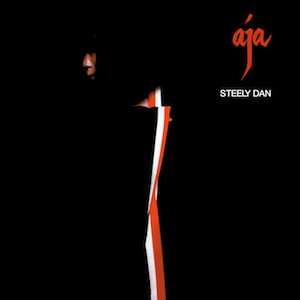 Steely Dan's Aja
Steely Dan's AjaDonald Fagen and Walter Becker are nothing short of slaves to perfection when it comes to recording and mastering; consequently, every Dan LP is an audiophile's dream. Aja was the third Steely Dan album since songwriters Becker and Fagen nixed the fixed band format in 1974, preferring the insular comfort of L.A. studios, recording their compositions with a loose network of session musicians and jazz giants. As a result, the framework of their music shifted to a clean and calculated mutation of various rock, pop and jazz idioms. Aja is filled with complex horn charts, synthesizers and lush background vocals that flirt with schmaltzy L.A. jazz riffs or Ray Conniff LPs. When it comes to the title track, it's the kind of production that Brian Wilson could only dream about when making "Good Vibrations." It is the single most aurally perfect song in the rock canon.
Each song on the album is a classic in its own right. You've heard them even if you think you never have. The tracks decorate the airwaves in every department store, elevator, classic rock radio station, and grocery store one can imagine. Try to resist if you will, but the Dan's sound is as much a part of the social fabric of America as that fearless excavation on Magnolia Boulevard or the hot dog man on the cover of Pretzel Logic. Aja may just steal Dark Side's thunder as the greatest LP ever produced.
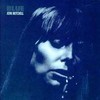 Joni Mitchell's Blue
Joni Mitchell's BlueI can go on and on about Blue, from my personal experiences in Jay and the Americans to the stripped down acoustic quality of the LP, it is another of my go-to LPs. But I don't have to. Here one will find a different kind of aural perfection. The LP is reasonably unadorned, with most of the LP filled with nothing more than Joni's piano and oddly tuned guitar, but Blue is raw in its approach and hi-fidelity will reveal every squeak of the guitar strings and even the pedals of the piano; the dynamic range is impeccable.
Published on August 12, 2018 05:47



